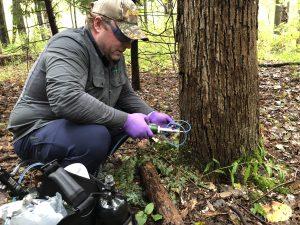Recently, we continued our Saving America’s Iconic Trees Tour with a stop at Cornell University. Along with members of the Cornell University staff, graduate students, and a Michael Grimm Landscape & Tree Service, we injected 47 trees, totaling 802” DBH, in the naturalized areas of the campus.
Choosing Our Trees
An Ash tree inventory was conducted earlier this year by Cornell’s Director of Natural Areas, Todd Bittner, and his staff. The trees were chosen regarding their impact on the walking trails, safety on the campus, and importance in the landscape. These were the trees we would focus our treatments on this time around, as we felt they would have the biggest impact.

One particular tree, which posed an interesting challenge was a large Ash, home to a hive of bees that are vastly important to the pollination of a many of the plants in the area. We concluded that we were able to inject the tree because it was well after pollination season, and Ash trees are pollinated by wind and not bees.
The Impact of Injection
Our injection sites on this trip included river banks, hill sides, and wetlands – all areas where applying sprays or soil drenches would be very difficult, and not as environmentally sound. In our efforts to keep the trees on this historic campus alive and beautiful for years to come, we were able to be more effective through trunk injection, and thrilled to be a part of this journey! It was a great opportunity to work with individuals who are so passionate about their landscape, and to help protect some amazing trees.
Nominate an iconic tree near you, and you may be the next stop on our Saving America’s Iconic Trees tour!
